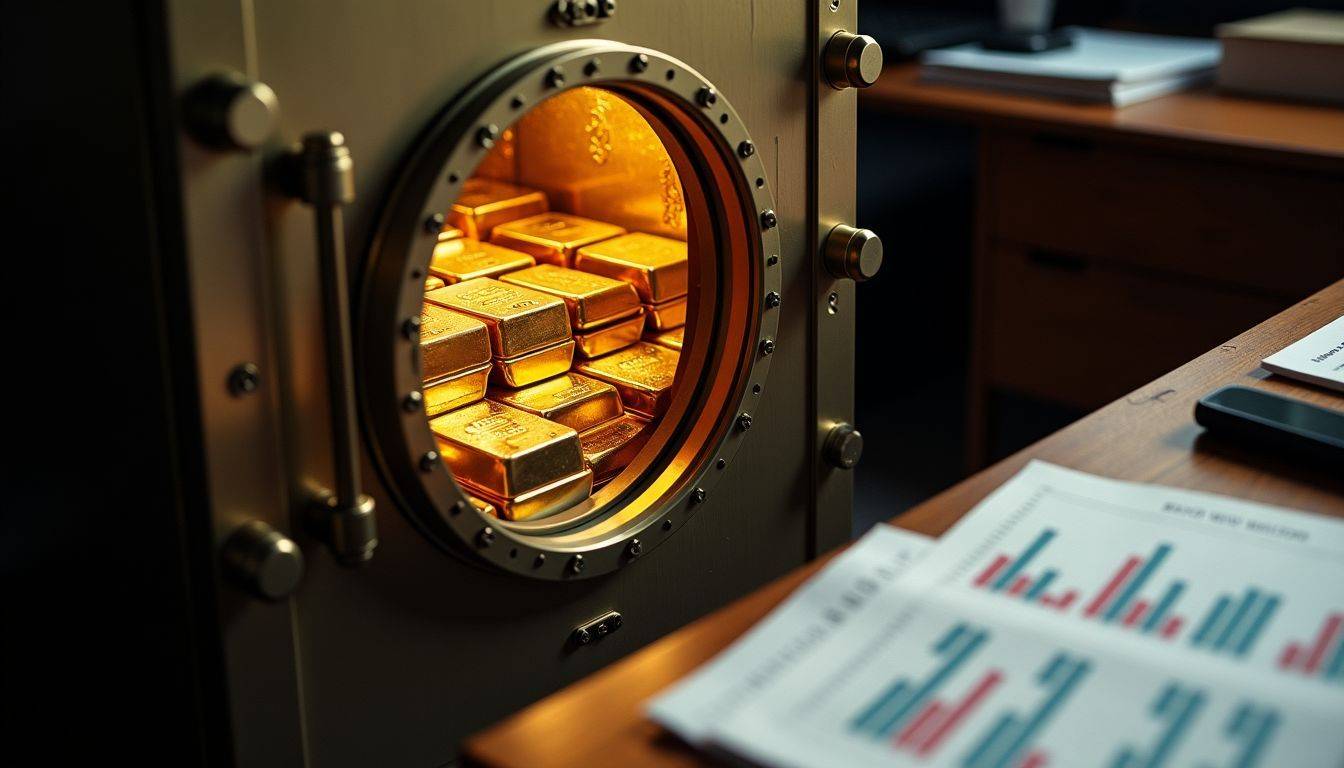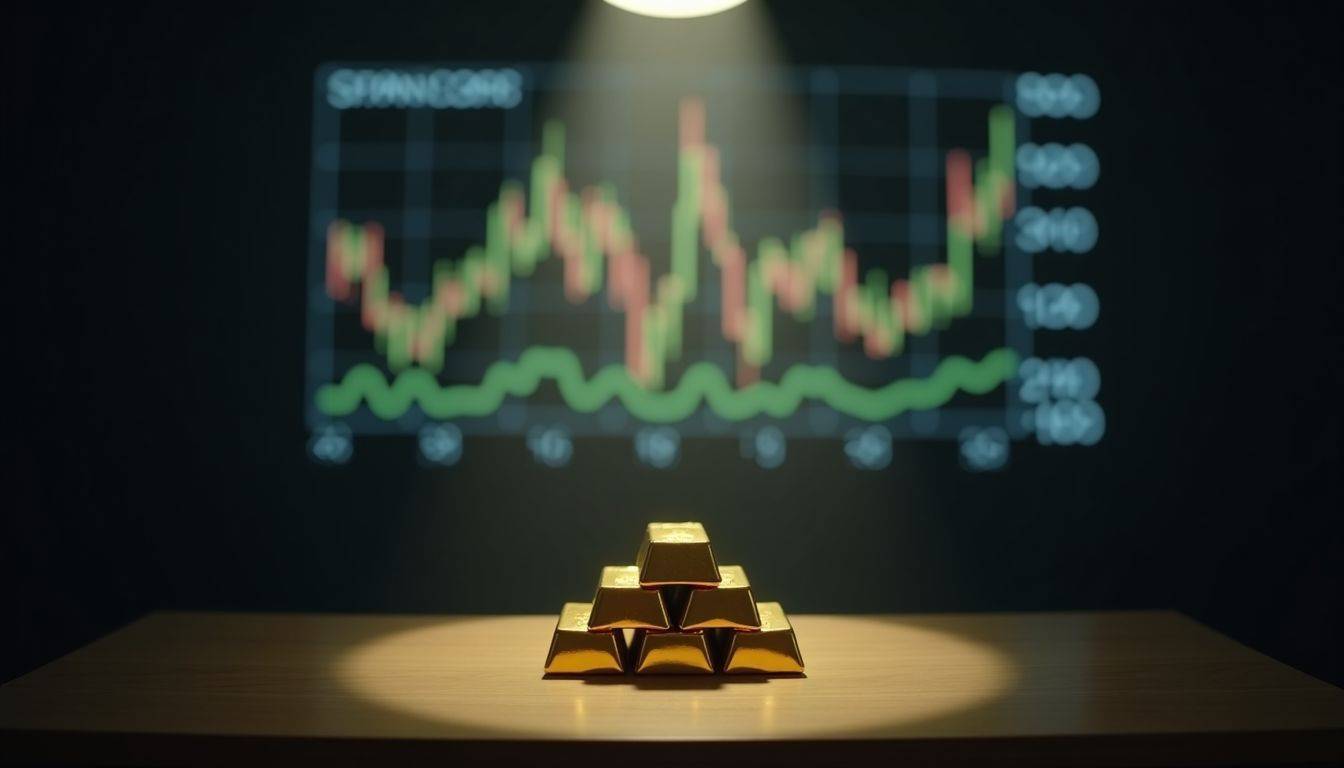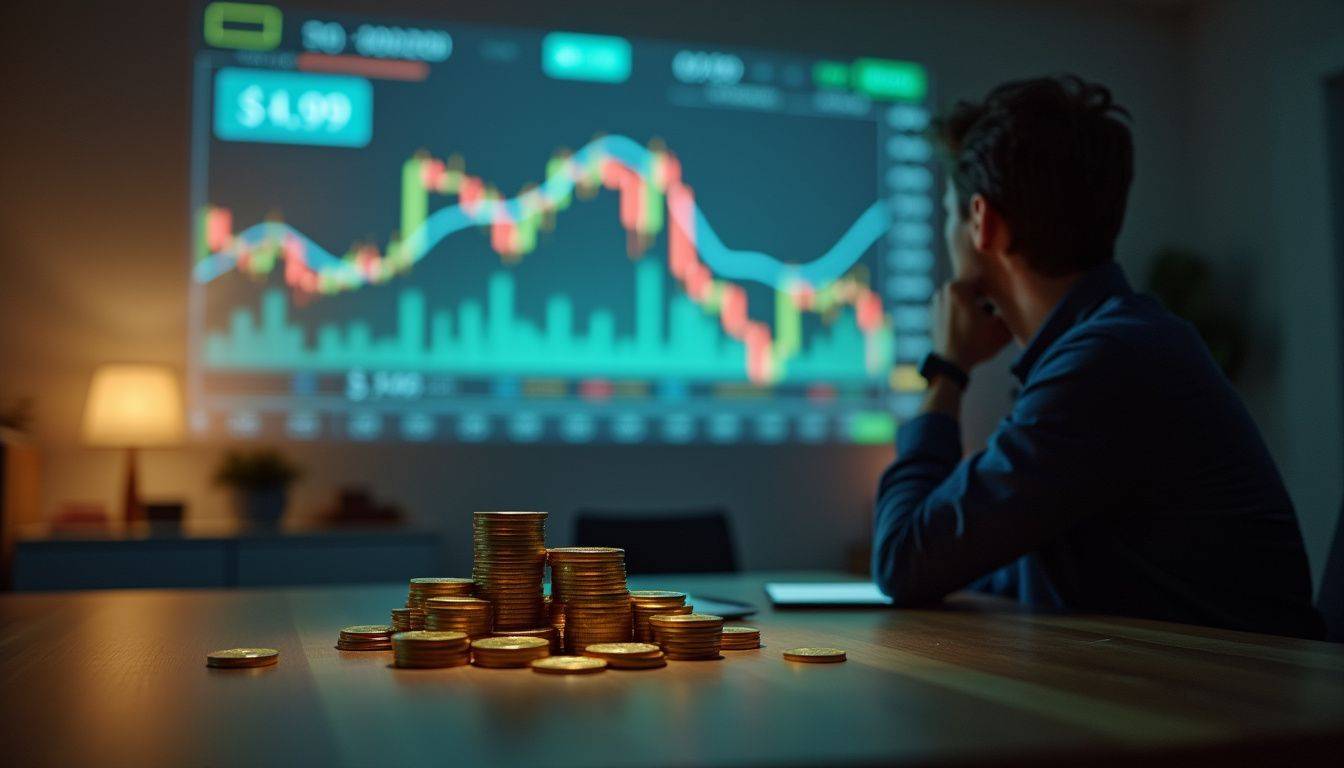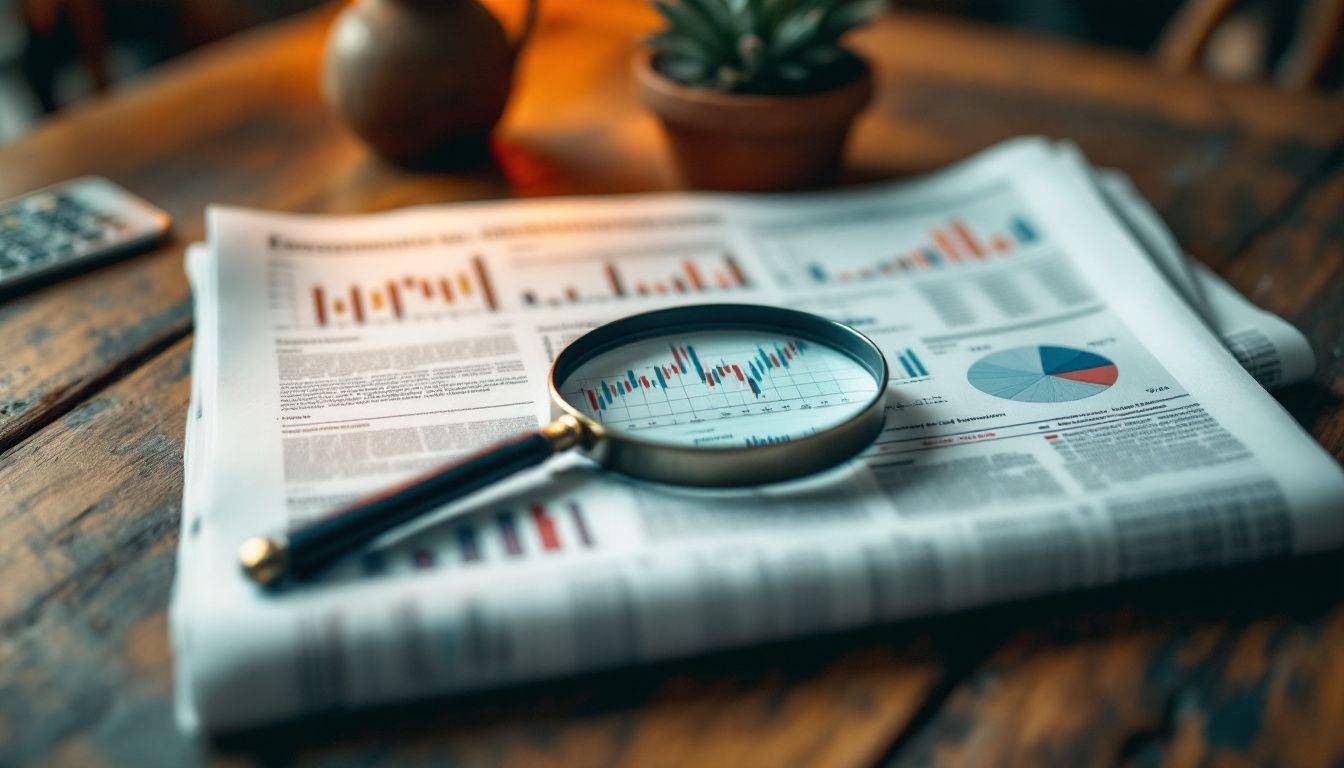You know how it feels when you save money to buy something, and just before you can buy it, the price goes up? It’s frustrating. Now imagine that with gold. People invest in gold because they think it is safe.
But sometimes, the price of gold goes up and down a lot. This makes people worry about their investments in other things like stocks or bonds.
One big fact: Gold prices change because of many things like how strong the dollar is, if people are scared about the economy, and how much gold mines are taking out of the ground.
This blog post will show you why these ups and downs happen and what they mean for your money in simple words. Plus, we’ll talk about some smart moves investors can make to protect their cash from these swings—staying clear of jargon that confuses more than it explains.
Ready to see how gold touches your wallet? Keep reading!
Factors Influencing Gold Prices

Gold prices can swing because of how people feel about the economy and what’s happening in the world. Things like how strong money is and if costs are going up, along with how much gold we have and want, play big roles.
Economic Uncertainty and Investor Sentiment Economic uncertainty makes people want gold more. They see it as a safe place to keep their money when things get shaky. Think about the COVID-19 pandemic. It scared everyone, and suddenly, lots of people wanted to buy gold.
Economic uncertainty makes people want gold more. They see it as a safe place to keep their money when things get shaky. Think about the COVID-19 pandemic. It scared everyone, and suddenly, lots of people wanted to buy gold.
This is because they were unsure about what would happen next. Gold’s value goes up and down with how investors feel. If they’re worried about the stock market or big problems in the world, they’ll likely turn to gold.
Daily updates on the market help these folks decide if it’s a good time to buy or sell gold. Watching trends in things like foreign exchange (Forex) and Bitcoin also gives clues about where gold prices might head next.
Smart investors use this info to tweak their plans, making sure they can handle whatever comes their way financially. Moving on, let’s talk about currency strength and inflation rates and how they play into all this.
Currency Strength and Inflation Rates
Gold rates swing with inflation and the strength of currencies. Strong dollars often make gold cheaper, as you need fewer dollars to buy the same amount of gold. On the flip side, when currencies weaken, gold prices tend to rise because it takes more money to purchase that gold.
It’s a dance between how much currency can buy and what’s happening in the world economy.
Inflation is like a signal that affects how people view their money’s worth over time. When inflation rises, each dollar you have buys less than before. This is where gold steps in as a sort of hero for investors.
It holds its value well against rising inflation, making it a key player for those looking to protect their wealth from losing power.
Understanding the balance between currency strength and inflation offers insights into smart investing in precious metals.
Next up, let’s check out how supply and demand play into all this.
Supply and Demand Dynamics
Moving from the impact of currency and inflation on gold prices, let’s talk about how much gold is out there and who wants it. This balance between supply and demand really sets the price.
The supply comes from mining gold out of the earth and recycling old gold stuff like jewelry. On the flip side, demand comes from people wanting to buy gold as a safe place for their money, especially when times get tough.
Countries growing fast, like some in Asia, want more gold which can push prices up. Sometimes things go wrong in getting gold from mines to market – think bad weather or machines breaking down.
This can make less gold available and also hike up prices. People trading in exchange-traded funds (ETFs), big banks holding onto gold bars, and these bumps in production play a huge part in this tussle between supply and demand.
Impact of Gold Price Fluctuations on Financial Markets

Gold price changes can make waves in the financial markets. These shifts affect everything from how much your dollar is worth to the safety of investing in stocks and bonds.
Hedge Against Inflation
Gold shines during challenging times. Consider it as your financial safeguard when inflation begins to surge. As prices increase, so does the value of gold. This elevates it to a favored choice for traders and investors who aim to safeguard their wealth from the diminishing power of paper money.
It’s crucial to understand that while cash may weaken in purchasing potential, gold typically grows stronger.
Here’s an intriguing fact—gold is more than just decoration; it’s a strategic approach for safeguarding investments. Imagine the following scenario: during times of inflation, when everything becomes pricier, gold holders can maintain a sense of calm.
Their asset often appreciates in value. This reality has led central banks and astute individuals alike to increase their gold reserves over the years—a proven method to protect against the covert enemy known as inflation.
Effects on Stock Market and Fixed Income Investments
As we think about gold as a way to protect money, it’s clear this choice touches the stock market and fixed income investments too. Gold moving up often means people are worried. So, they pull back from stocks.
Think of it like a teeter-totter. When gold goes up, stock investments can go down. This is because folks seek safety in gold rather than risky stocks.
Fixed-income stuff like bonds may also feel the changes when gold rates shift. If investors expect bad times ahead or inflation to rise, they might go for gold over bonds. It’s all about finding balance in rough seas.
Gold shines brightest when clouds gather on the financial horizon.
This dance between gold, equities (stocks), and bonds shows how connected our investment choices are. Rising interest rates usually hurt bond prices but can make people run to safe things like U.S Treasuries or even back into equities if they believe those will outperform other options despite the risks.
Influence on Currency Valuations
Shifting gears from how gold rates affect stocks and bonds, we find that they also play a big role in the value of money around the world. Countries that sell a lot of gold often see their currency get stronger when gold prices go up.
On the flip side, if gold prices drop, these countries’ currencies might weaken too. This is because high gold prices mean more money flowing into these countries from buyers around the globe.
For investors and traders keeping an eye on Forex markets, understanding this link is key. They use it to make smart moves with their money. If you know which way gold prices are heading, you might guess what will happen to certain currencies.
For example, if Australia’s selling lots of gold at high prices, the Australian dollar might rise too. So, watching trends in the market for this shiny metal can help predict changes in global currency values.
Gold as a Safe Haven Asset

When the market gets wild, many people turn to gold. It’s like a calm port in a stormy sea for your cash. Gold shines when other investments might make you nervous. Want to keep your money safe and sound? Then reading more about gold might be a bright idea!
Resilience During Economic Crises
Gold shines brightest when times get tough. During economic crises, people flock to gold as a safe haven asset. It’s like a security blanket for investors. They know that even if the stock market crashes or currencies fall, gold will hold its value.
This makes investing in gold a smart move to protect against inflation and currency devaluation.
In challenging times, gold stands as a beacon of stability.
Look at what happened during the global financial crisis. The value of many investments fell sharply, but not gold. Its price went up because more people wanted it as protection against uncertainty.
Gold acts as a hedge—it keeps your money safe when everything else seems risky.
Performance During Recessionary Periods
During hard economic times, gold shines as a beacon for worried investors. Its value often moves opposite to other investments like stocks or bonds. Think of it as a financial lifeboat that keeps you safe when the market sea gets rough.
Lots of people turn to gold, making its demand and price go up.
In past recessions, this pattern has played out clearly. For example, during the big financial crisis over a decade ago, while many lost faith in traditional investments and watched their values plummet, those holding gold saw its worth increase.
This isn’t just about following trends; it’s about understanding how gold acts as insurance for your portfolio when things get shaky in the global economy.
Comparison with Other Safe Haven Assets
Continuing the discussion on gold’s performance during economic instability, let’s examine how it compares with alternative investment options during uncertain periods. It’s common knowledge that during challenging times, investors seek reliable assets. Preferred choices include Gold, Forex, Oil, Indices, and Bitcoin. Considering these options, how does gold perform? We’ll outline this in a straightforward manner.
| Asset | Why It’s a Safe Haven | Risks |
|---|---|---|
| Gold | Consistently sought after, maintains value even when the dollar weakens. | Prices can fluctuate due to sudden market changes. |
| Forex (US Dollar, Swiss Franc) | Perceived as stable currencies. They are favored in times of trouble. | Subject to economic disruptions specific to their nation. |
| Oil | Necessary commodity, consistently in demand. | Price can be affected by an imbalance in supply or demand. |
| Indices (S&P 500, Dow Jones) | Diversifies risk by investing in a variety of companies. | Can decline during an economic downturn. |
| Bitcoin | Finite supply, operates independently from governmental interference. | Subject to high volatility due to its relative novelty. |
Gold occupies a distinct position among safe-haven assets. Its role is comparable to that of the reliable, seasoned family member – trusted and consistent, particularly in turbulent times. While gold prices may fluctuate with market sentiment, it maintains an intrinsic value that other assets find challenging to replicate.
Monitoring the gold market offers insights into the broader sentiment regarding safe-haven assets. An increase in gold’s price can indicate growing economic concerns and a shift towards assets perceived as more secure.
If you’re considering an investment in gold, complementing it with Forex, or experimenting with Bitcoin, understanding global events is crucial. This insight will inform your investment decisions. Gold, renowned for its stability through economic cycles, often provides valuable signals for investors.
Harnessing the Power of Gold Rates for Financial Growth
 Gold rates move up and down. This can help people grow their money if they pay attention. Keeping an eye on these changes gives clues about where the market might go next. Experts give advice on how to make smart moves with gold investments.
Gold rates move up and down. This can help people grow their money if they pay attention. Keeping an eye on these changes gives clues about where the market might go next. Experts give advice on how to make smart moves with gold investments.
They use facts, data, and trends to help us decide when to buy or sell.
The secret to financial growth is not just in knowing the current value of gold but in predicting its future movements.”
People use Exchange Traded Funds (ETFs) and physical gold bits as ways to invest. These choices let them spread out their risk while aiming for good returns. Watching daily updates from analysts improves how well they do.
Gold’s rise and fall impact many areas of finance, like stocks and currencies. This makes it a key part of a smart investor’s plan.
Strategies for Investors

Investors have a lot of options for growing their money with gold. They can look into gold exchange traded funds (ETFs) and real pieces of gold to mix things up in their portfolios.
Diversifying with Gold ETFs and Bullion
Gold ETFs and bullion serve as intelligent choices for diversifying your investment portfolio. This strategy can aid in better management of market volatility. Here is a process to follow:
- Initiate by incorporating gold bullion into your portfolio. Envision gold bars and coins. They represent palpable value.
- Incorporate a variety of gold ETFs. These are analogous to collections of gold-related investments that can be traded on the stock market. They offer the convenience of trading, akin to stocks.
- Gold ETFs provide an opportunity to invest in gold mining companies. Therefore, the performance of these companies directly impacts your investment.
- Possessing both bullion and ETFs prepares you for diverse economic climates. If cash depreciates due to inflation, your gold should maintain its worth.
- Bullion acquisition offers a direct method to possess real gold. It’s tangible but liquidating it might require more time compared to stocks or ETFs.
- ETFs provide agility to adapt if the market fluctuates. They offer a swift method to adapt to price variations in gold rates.
- Investing in both categories enables risk distribution. If one underperforms, the other might compensate.
- You also gather insights from two markets – physical gold and financial products associated with gold.
- Owning physical gold entails costs associated with storage and insurance.
- Identify reputable dealers for bullion acquisition to evade counterfeits.
- Monitor prices daily – for both physical gold and ETF shares –to maintain an advantage.
- Adopt a long-term perspective; abrupt spikes in price don’t always signify immediate sale or purchase.
- Consult a financial adviser regarding the optimum way to integrate these assets into your other investments.
- Keep an eye on associated fees with ETFs – they can accumulate over time.
- Ultimately, take pleasure in expanding your knowledge about another segment of the international finance system while judiciously growing your wealth with gold!
Timing the Market: When to Buy and When to Sell
Understanding when to buy and sell gold can make a big difference for traders and investors. Here’s a list to guide you through timing the market for gold investments.
- Watch the global financial system signs.
- Look for times of economic uncertainty.
- Notice when inflation rates start to climb.
- Keep an eye on U.S. dollar strength.
- Follow central banks’ actions on gold.
- Track supply changes in major gold-producing countries.
- Pay attention to demand from industries and technology sectors.
- Check historical price charts during past crises.
- Use news about global events that could affect markets.
These steps help in making informed decisions about buying or selling gold as part of a diversified investment plan.
Next, let’s explore strategies for investors to diversify with gold ETFs and bullion.
Long-term vs. Short-term Investment Approaches
Gold trading affects how people plan their investments. Some like to keep their gold for a long time, while others prefer quick trades. Here’s why both can be smart moves:
- Long-term investors look at the big picture. They know gold keeps its value over many years.
- These folks don’t worry much about daily price changes. Instead, they think about how gold prices go up over decades.
- Gold helps them protect their money against inflation, meaning it can buy the same amount of stuff even when prices for things go up.
- They often buy gold bars or coins and keep them safe, maybe in a bank or a safe place at home.
- For long-term success, they watch market trends but don’t act on small price changes.
Short-term traders live in a different world:
- They watch the market like hawks, ready to buy or sell based on daily news.
- Big events, like economic reports or global issues, can make them decide to trade quickly.
- These traders use tools like gold ETFs (Exchange Traded Funds) because they’re easy to trade fast.
- They aim to make small profits that add up over time instead of waiting for one big win.
- Knowing when to jump in and out of the market is key for them.
Both groups use current gold rates to guide their choices, but their goals are very different. Long-term folks want safety and steady growth, while short-term traders seek quick gains from market moves.
Future Outlook

Thinking about the future, we expect gold prices might swing based on economic hints like inflation rates or currency values. Investors will likely adjust their steps depending on these clues.
Check out more to stay ahead in the game!
Predictions on Gold Prices Based on Current Economic Indicators
Looking at economic indicators, we can guess where gold prices might go. High inflation rates make gold more attractive. People buy it to protect their money’s value. When the U.S. dollar is strong, fewer people buy gold.
This makes its price drop. But if the dollar weakens, expect gold prices to rise because it becomes cheaper for folks with other currencies.
Supply and demand also tell us about future gold prices. If miners produce less gold or if there are problems getting gold from the ground, prices could go up due to less supply. On the flip side, if there’s too much gold available or not enough buyers, prices could fall.
Now let’s talk about what investors might do next based on these predictions.
Potential Shifts in Investor Behavior
Gold rates change every day. This makes traders and investors think twice about where to put their money. They might move from gold to things like Forex or Oil. Or they could choose another path based on market trends.
Market updates help a lot. They tell traders when it’s smart to act. Advice from experts also guides them on how to adjust their plans with the ups and downs of gold prices. Plus, learning more about how gold moves can push people to try new investment styles or areas they hadn’t thought of before.
Conclusion

Keep an eye on gold prices. They move a lot and change how we invest. Gold can guard your money when prices go up fast. It also moves differently than stocks or bonds, which can be good for mixing things up in your investment pouch.
Think about adding gold to your mix with things like ETFs or real gold pieces. Know the right times to buy and sell for the best gain.
Using these ideas could really pay off. If you’re thinking about where to learn more, lots of websites and videos are out there talking about gold investments every day. So, don’t wait too long! Jumping into investing with a bit of knowledge about gold could help keep your money safe and growing.
And here’s me saying – it’s okay if this sounds big or scary at first glance; many have walked this path before you did and found success along the way!
FAQs
1. What’s the deal with gold rate fluctuations and financial market investments?
Well, when you’re talking about gold as an investment, you’ve got to consider how the value of the U.S. dollar affects it. If our greenback goes down – boom! The price of gold usually shoots up.
2. How does inflation play into all this?
Great question! Gold is often seen as a “flight to safety” during times of inflation or credit crisis. It holds its real value even when fiat currencies like our good old dollar are depreciating.
3. So what happened with gold during the pandemic?
Ah, now that was interesting! We saw some major changes in gold production due to health concerns for miners and disruptions in supply chains…not exactly a bull market for them!
4. Are there any specific investment products tied to gold?
Absolutely! You can invest directly through buying physical gold (though it tends to be rather illiquid) or go for Exchange Traded Funds (ETF) that track underlying assets such as U.S treasuries or the Dow Jones Industrial Average.
5. I’ve heard something about hedging with gold—what does that mean?
Hedging is like insurance against your other investments going sour—it helps balance your asset-allocation strategy by providing some stability against depreciation and bear markets.
6. So, should I put all my money in Gold then?
Whoa their partner, not so fast! While investing in Gold has its perks, it’s crucial not to overlook risks associated with speculation and liquidity constraints…always remember diversification is key!





